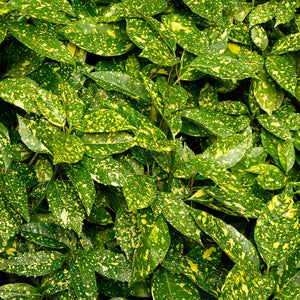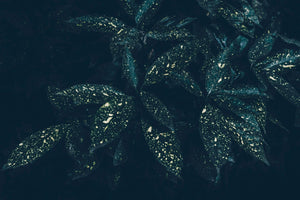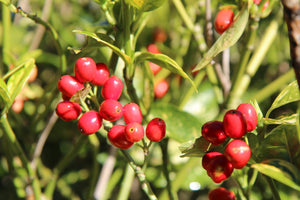The Aucuba Guide
Aucuba plants are a great addition to any garden or landscape, offering year-round interest with their glossy, evergreen leaves and vibrant berries. With the right planting and care, these hardy plants can thrive in a variety of conditions. Whether you choose a dwarf or larger variety, there is an Aucuba plant that can suit your needs and enhance the beauty of your yard.

About
Aucuba is a genus of flowering evergreen shrubs native to eastern Asia, particularly Japan and Taiwan. The most commonly cultivated species is Aucuba japonica, which is widely grown as an ornamental plant for its attractive foliage.
Aucuba japonica typically grows up to 10 feet tall and wide, but there are dwarf cultivars that are much smaller. The plant has large, glossy leaves that are oval-shaped and pointed at the tip. The leaves are usually dark green, but there are variegated cultivars that have yellow or white markings.
In the spring, Aucuba japonica produces small, reddish-purple flowers that are followed by bright red berries in the fall. Both the flowers and berries are insignificant, and the plant is mostly grown for its foliage.

Planting
Aucuba have specific requirements that must be met in order to keep them healthy and thriving. Here are some general guidelines for planting and caring for Aucuba:
Soil: Aucuba prefer well-drained soil that is rich in organic matter. They thrive in slightly acidic to neutral soil with a pH between 6.0 and 7.0. If your soil is too alkaline, you can amend it with sulfur or other acidic materials to lower the pH.
Sunlight: Most Aucuba varieties prefer partial to full shade, depending on the species. When choosing a location for your Aucuba, consider the amount of sunlight it will receive throughout the day.
Watering: Aucuba require regular watering, especially during their first few years of growth. Water deeply and thoroughly once or twice a week, depending on the weather and soil moisture levels. Be careful not to overwater, as Aucuba plants can be susceptible to root rot in soggy soil.
Mulching: Mulch around the base of your Aucuba to help retain moisture and regulate soil temperature. Use a layer of organic material such as wood chips, bark, or compost, and keep the mulch a few inches away from the trunk to prevent moisture buildup.
Pruning: Aucuba generally do not require much pruning, but you can shape or trim them to control their size or remove dead or damaged branches. Prune in late winter or early spring before the new growth appears.
By following these basic guidelines, you can ensure that your Aucuba thrives and adds beauty to your landscape for years to come.

Care
Aucuba shrubs require moderate watering, typically about one inch of water per week, depending on rainfall. During periods of drought or high temperatures, they may require more frequent watering to prevent stress and dehydration. Be sure to water deeply and thoroughly, rather than shallowly and frequently, to encourage deep root growth.
Aucubas are generally low-maintenance plants and do not require heavy pruning. However, you may need to remove dead or damaged branches or shape the plant to maintain its desired size and shape. Prune in late winter or early spring before new growth appears, using clean, sharp tools to avoid damaging the plant.
Fertilizing can help promote healthy growth and foliage in Aucubas. Use a slow-release, balanced fertilizer in the spring or early summer, following the manufacturer's instructions for application rates and timing. Be careful not to over-fertilize, as this can burn the roots and damage the plant. If in doubt, it's best to err on the side of caution and apply less fertilizer rather than more.
With these basic care guidelines, your Aucuba shrub can thrive and provide beauty and enjoyment for many years to come.

How To Use
Aucuba is a versatile and attractive plant that can be used in a variety of ways in the landscape, depending on its size and shape. Here are some recommendations based on its growth habits:
Small Aucuba: These are perfect for small gardens or as accent plants in mixed borders. They typically grow to a height of 2-4 feet and have a compact, upright form. Recommended varieties include Aucuba japonica 'Nana.'
Medium Aucuba: These are great choices for use as hedges, foundation plantings, or as specimen plants in smaller landscapes. They typically grow to a height of 5-6 feet and have a dense, bushy form. Recommended varieties include Aucuba japonica 'Variegata.'
Large Aucuba: These make a bold statement in the landscape and are best used as specimen plants or in mixed borders with plenty of space to grow. They typically grow to a height over 7 feet and have an open, spreading form. Recommended varieties include Aucuba japonica 'Gold Dust.'
When selecting an Aucuba for your landscape, consider the mature size and shape of the plant, as well as its growth rate and environmental requirements. With proper care and placement, Aucuba can provide beauty and enjoyment for many years to come.
Conclusion
Aucubas are a beautiful and versatile addition to any landscape. With proper planting and care, they can thrive in a variety of conditions and provide years of enjoyment. Whether you choose a compact or larger variety, there is an Aucuba that will suit your needs and enhance the beauty of your yard.







